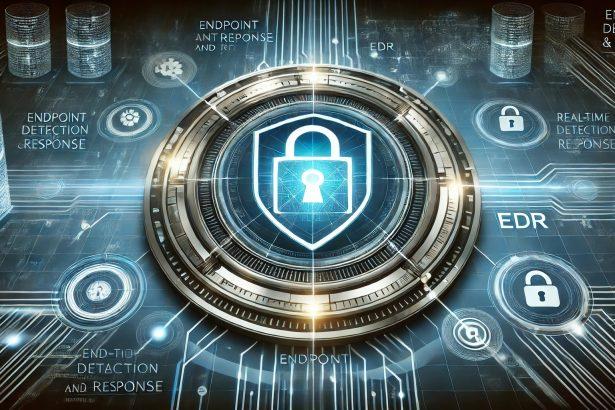You’re running a business, and suddenly, one of your employees unknowingly clicks a malicious link. Within seconds, malware spreads across your network, exfiltrating sensitive data. Scary, right? This is where Endpoint Detection and Response (EDR) comes in, acting as your digital guardian, detecting, analyzing, and responding to threats before they wreak havoc.
But here’s the catch—EDR can’t do its job without properly deployed agents. Whether you’re a cybersecurity pro or just getting started, this guide will walk you through the entire EDR agent deployment process, ensuring your endpoints remain locked down against cyber threats.
What is an EDR Agent and Why Does It Matter?
Think of an EDR agent as your security team’s eyes and ears on every endpoint—be it laptops, desktops, or servers. These lightweight software components continuously monitor endpoint activity, collect real-time data, and flag suspicious behavior. Unlike traditional antivirus solutions, EDR agents don’t just block threats; they track, analyze, and respond to security incidents before they escalate.
Getting Ready: Pre-Deployment Considerations
Before diving into deployment, let’s ensure you’re fully prepared. Here’s what you need to check:
Choose the Right EDR Solution
Not all EDR solutions are created equal. When selecting one, consider:
- Scalability – Can it protect all your endpoints, even as you grow?
- Integration – Does it seamlessly work with your SIEM, XDR, and other security tools?
- Cloud vs. On-Prem – Cloud-based EDR provides remote deployment, whereas on-prem requires direct management.
Check System Requirements
Make sure your endpoints meet the following:
- Supported OS (Windows, macOS, Linux, mobile)
- Sufficient CPU, RAM, and storage
- Network access to EDR servers and cloud services
Set Security Policies
Define your detection and response policies based on:
- Threat severity levels
- Automated response actions (isolation, remediation, rollback)
- Compliance requirements (GDPR, HIPAA, SOC 2, etc.)
Deploying EDR Agents: The Best Methods for Success
Now that you’re ready, let’s talk about the best ways to deploy EDR agents across your organization.
Manual vs. Automated Deployment
- Manual Deployment: Suitable for small-scale rollouts or testing
- Automated Deployment: Ideal for large-scale businesses using tools like Microsoft Group Policy (GPO), SCCM, Intune, Ansible, or third-party scripts
Step-by-Step Installation Guide
Here’s how to deploy EDR agents across different systems:
Windows:
- Download the EDR agent MSI or EXE installer.
- Run the installer with admin privileges.
- Authenticate and link the agent to the EDR management console.
MacOS:
- Install via PKG or script.
- Approve necessary system permissions.
- Connect to the security server.
Linux:
- Use YUM, APT, or custom shell scripts.
- Enable kernel modules for advanced threat detection.
- Verify agent activity with
systemctl.
Mass Deployment Methods
For enterprise-scale deployment, automate the process using:
- Active Directory Group Policy (GPO) – Ideal for Windows-based organizations
- Microsoft Intune & SCCM – Deploy EDR agents remotely
- Cloud-based solutions – Directly install agents on endpoints regardless of location
Post-Deployment: Optimizing for Maximum Security
Deployment is just the beginning. Here’s how to ensure your EDR agents are working at peak efficiency:
Ensure Proper Agent Connectivity
- Check logs to confirm successful communication with the EDR console.
- Resolve network or firewall issues if the agent is not reporting data.
Fine-Tune Performance Settings
- Adjust real-time monitoring settings to balance security and system performance.
- Prevent CPU or memory overuse with custom scanning schedules.
Integrate with SIEM and Security Operations Centers (SOC)
Forward real-time security events to your SIEM (Splunk, ELK, Microsoft Sentinel) for enhanced threat visibility and correlation.
Validate EDR Effectiveness
- Use frameworks like MITRE ATT&CK to simulate cyberattacks.
- Run periodic penetration tests and red team exercises to gauge detection accuracy.
Monitoring and Managing Your EDR Agents
Ongoing management is crucial. Keep your security posture strong with these best practices:
Continuous Monitoring & Log Analysis
- Use your EDR dashboard to track endpoint activity and threat alerts.
- Investigate anomalies and adjust policies accordingly.
Handle False Positives Smartly
- Fine-tune detection rules to avoid unnecessary alerts.
- Use behavioral analytics to distinguish real threats from normal activity.
Keep Agents Updated & Healthy
- Enable automatic updates to patch vulnerabilities.
- Regularly check for misconfigurations and outdated agents.
Common Deployment Challenges & How to Fix Them
Even with the best planning, things can go wrong. Here’s how to tackle common issues:
- Agent Installation Failures? Run the installer with admin privileges and check for missing dependencies.
- Agents Not Reporting Data? Verify network configurations, firewall settings, and authentication credentials.
- High Resource Usage? Optimize scanning intervals and fine-tune real-time detection settings.
Best Practices to Strengthen Your EDR Deployment
To ensure long-term security, follow these best practices:
- Test before full deployment – Start with a pilot phase.
- Enforce least privilege access – Restrict administrative rights.
- Use multi-layered security – Combine EDR with SIEM, XDR, and firewalls.
- Educate employees – Train staff on phishing threats and endpoint security hygiene.
Final Thoughts: Stay Ahead of Cyber Threats
Deploying EDR agents is one of the most effective ways to secure your organization against modern cyber threats. But security doesn’t stop at deployment—you need continuous monitoring, fine-tuning, and proactive defense strategies to stay ahead of attackers.
With the right approach, your EDR solution can be a powerful, proactive force, keeping your endpoints—and your business—safe from ever-evolving threats.
Protect Your Business’ Cybersecurity Now!
Protect your business from evolving cyber threats with our tailored cybersecurity solutions designed for companies of all sizes. From malware and phishing to ransomware protection, our multi-license packages ensure comprehensive security across all devices, keeping your sensitive data safe and your operations running smoothly. With advanced features like real-time threat monitoring, endpoint security, and secure data encryption, you can focus on growth while we handle your digital protection. **Request a free quote today** for affordable, scalable solutions and ensure your business stays secure and compliant. Don’t wait—get protected before threats strike!





 Free Scan Available
Free Scan Available